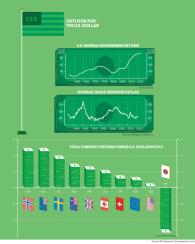Talk of currency wars is once again in the air, making foreign exchange potentially a major component of investment returns. That was certainly the case last year. The dollar underperformed all major currencies except the yen in 2012, particularly in the second half of the year, when the easing of the euro crisis reversed some of the safe-haven flows that typically benefit the greenback. The Federal Reserve’s quantitative easing policy has flooded global markets with dollars, putting downward pressure on the currency. The dollar also faces some longer-term challenges: The U.S. currency’s trade-weighted value has trended lower for most of the past decade as government debt has risen sharply. Although U.S. debt growth has slowed, it still remains on an upward trajectory, adding to the dollar’s negatives.
Which currencies stand to benefit if the dollar continues to decline? The best performers last year were commodity-backed plays like the Norwegian krone and relatively high-yielding currencies like the Australian and New Zealand dollars. If the global economy strengthens this year, putting upward pressure on commodity prices and rates, those currencies should continue to do well.
— The Editors





